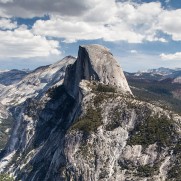This website uses cookies so that we can provide you with the best user experience possible. Cookie information is stored in your browser and performs functions such as recognising you when you return to our website and helping our team to understand which sections of the website you find most interesting and useful.
How Everything Goes Right When Everything Goes Wrong in Yosemite
May 18, 2015
John Muir once said of Yosemite, “It is by far the grandest of all the special temples of nature I was ever permitted to enter.” So, if I told you our standard week-long trip to this exalted and magical place was cut short to two days because of weather conditions, I imagine you’d be thinking, it must’ve been a disaster!
Well, does Ford look worried to you (below)?

Okay, he does kinda look worried, but that’s just the way he looks in pictures.
The thing about nature photography is, along with all the planning, experience and skill it takes to get awesome stuff — it takes just as much luck. If light is the photographer’s paintbrush, imagine Mother Nature as some eccentric old lady that comes in and messes with all your brushes and changes out all your paint at the last second.
Sure, you can find an iconic location, do all your research, plan the time of year, time of day, know what gear you need, but that doesn’t mean that crazy old lady is gonna cooperate. Sometimes all your prep and planning comes down to the luck of the draw. Is she going to ruin your vision? Or give you something even more spectacular you didn’t expect?
This is what our trip to Yosemite was all about. Mother Nature stole all our paintbrushes, but left us some awesome paint. With a mix of experience, planning and a little luck, we were able to make some beautiful images and cover more in two days than we would during an average shoot.
The trip got off to an auspicious start when we did our routine pre-shoot weather check. A storm was rolling in and looked to stick around. But in a place like Yosemite, it’s hard to tell what a storm will look like. Wall-to-wall overcast and rain? Will there be clear patches? And, is it even accurate? If I were wrong at my job as often as forecasters are, I’d be fired.
Areas with large peaks and valleys can create their own weather systems and play by their own rules. Sometimes you have to be a bit of a forecaster yourself, getting a feel throughout the shoot how the weather is shifting and affecting the light.
A grey, overcast day makes for boring vistas. But, when it clears, it can make for amazing landscapes, adding intrigue to the sky and interesting shadow patterns to the land below. These weather patterns can clear out valley haze and soften harsh light.
If you get a little lucky, and do your due diligence in the research phase, you can find yourself in the right place at the right time and get shots during times of day you normally wouldn’t. Our shot at Glacier Point (below) is a perfect example.

You wouldn’t know it, but this was taken at the worst time of day. Usually the middle of the day is absolute garbage. The sun gets hotter and washes out any kind of stone. There’s too much contrast and you get harsh shadows and glare. Vistas get real hazy. It’s just yucktastic.
I call this tourist time. The light is gone, but the tourists are finally up and about taking selfies hugging half dome or something like that, wondering why they can’t get the beautiful view to show up on camera.
But, in this instance, we were right in-between two weather systems. There were nice clouds in the sky, the light was unusually soft and there was no haze. So we took a gamble on driving out there. Experience + luck.
That’s just the way things went in Yosemite. We only got two days, but we got to shoot continuously.
The morning shoots were clear. Cloud cover softened midday light. When storms rolled in, they provided perfect light to shoot the many rapids and smaller waterfalls. And when there was a break in the afternoon storms, we’d find ourselves in the perfect position to get the truly epic stuff.

Tunnel View (above) is one of the more iconic shots of Yosemite, immortalized by photographer Ansel Adam’s “Clearing Winter Storm.” We tried this shot three different times before we caught it.
The light hits the valley later in the evening, but every evening called for rain, rendering this beautiful landscape just, bleh. But we knew there was a chance that Tuesday afternoon could see a break in the storm, and maybe provide something special.
So we got there about 1 p.m. and just sat. And sat. Watched the tourists click away in vein at the dimly lit valley.
Finally, as we were just about to give in around 4 p.m., a little blue popped up over the hill behind us. We knew it was happening. After about 20 more minutes that patch of blue set itself right over the valley, the sun came out to play, baby unicorns frolicked, and all was good. Planning + luck.
We were able to capture the essence of such an amazing park in just two days, all just because everything went right when everything was going wrong.









